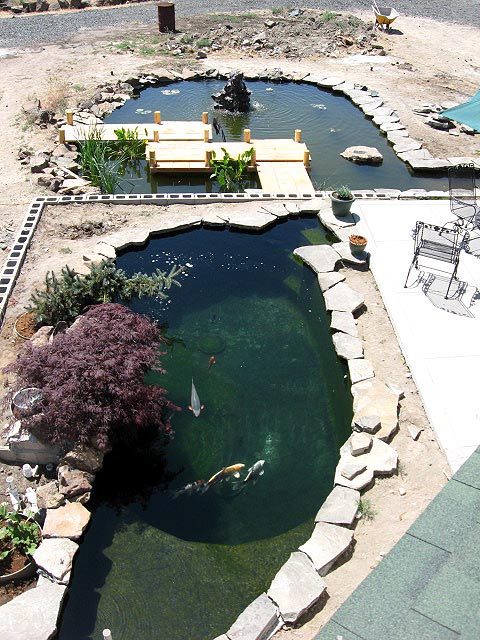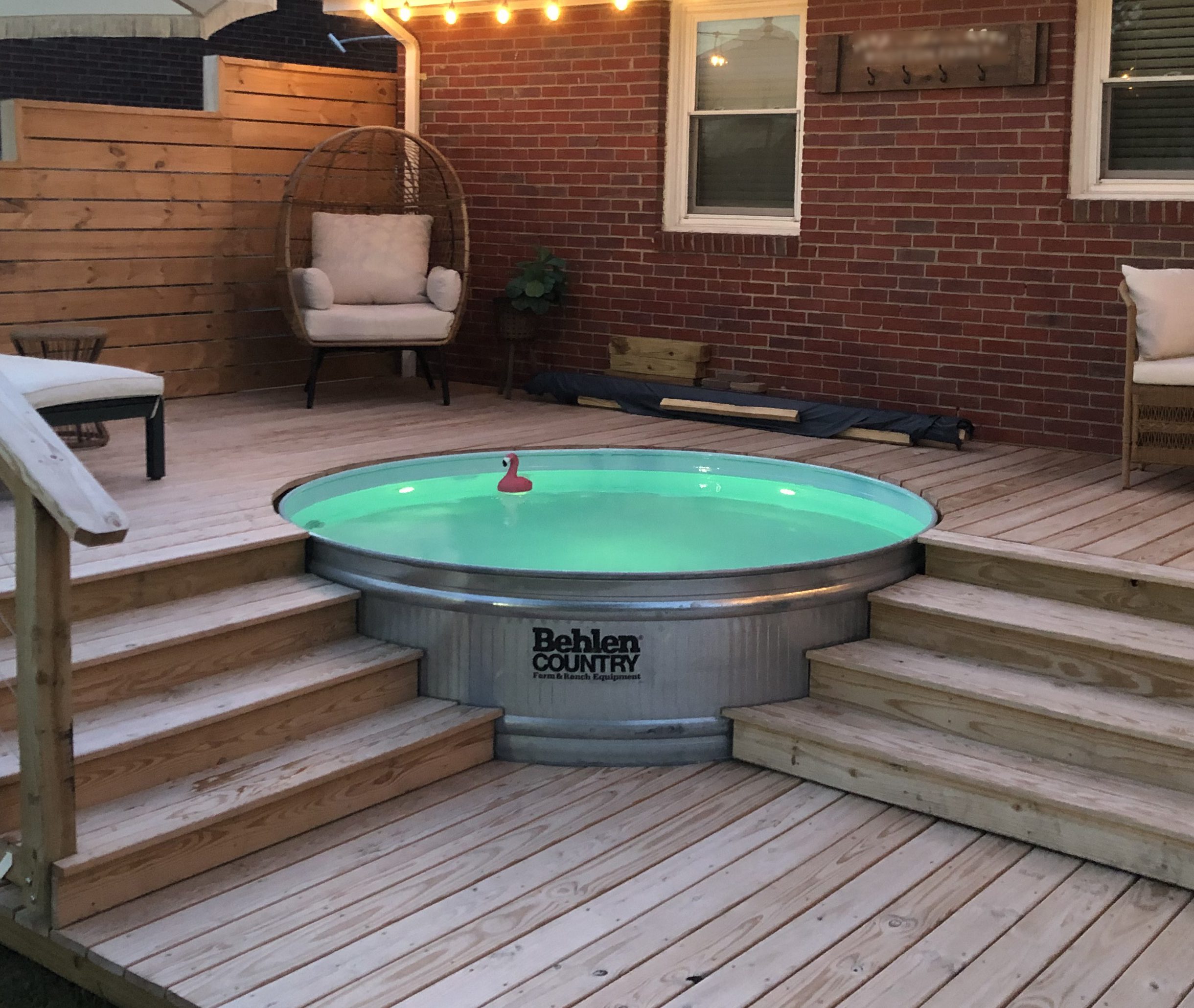

So You Want a Stock Tank Pool
Well this is going to be an exciting Stock Tank pool project, isn’t it? Let me first start out by saying that we have a video tutorial of coating a stock tank on our YouTube channel and after reading this, you should have a peek at it for more visuals. This article is designed to be a place where I can add/adjust detail in the process where I cannot do that in an already processed video. Let’s get started.
Supplies needed for coating a stock tank pool?
Well that’s easy. A stock tank! Ok, I’m sure you knew that already, but what other things do you need to get this project done?
- Several $3-$4 polyester paint brushes
- Plastic Bondo spreader
- Mixing cups
- Mix sticks
- Measuring cups (if your mix cups do not have measuring indicators already on them)
- Green tape
- Goggles
- Gloves
- Angle grinder
- Flexible sanding disks (60 grit or 36 grit)
- Vacuum
- Rags
- SEM self-etching primer or SEM rust converting primer (or both depending on your circumstances)
- Pond Shield non-toxic epoxy coating
First Steps
The very first thing that needs to be done is to evaluate the stock tank you plan on converting to a swimming pool or other water feature. If the stock tank is new, it will probably be corrosion free and simply have a nice layer of galvanization on it. However, If the stock tank is previously used, then it may have issues like corrosion or leaks on seams, etc. If there are too many problems with the stock tank may very well dictate not even using it. It is best to use your best judgment before starting.
Next, the best thing to do would be to determine the final installation space for the stock tank. This area needs to be set up and ready for the stock tank as soon as the coating has been applied. The area does not have to be completely dressed, but rather things like the ground needs to be prepared. This means using soft, self-leveling types of material like sand to set the tank onto should be in place and ready to go. If you are planning a filtration or heating system, then these areas need to be mapped out as well.
Decking, faux walls, plants and other accruements can be put into place after the stock tank has been installed. Just be sure to cover the stock tank while outside building takes place in order to protect the coating during that process.
Preparation
The galvanized coating on these stock tanks is a great corrosion preventative measure but it does not last very long and does not work well in a chlorinated environment. It is for this reason alone that applying Pond Shield Non-Toxic Epoxy Coating is important. Pond Shield, when properly applied, will protect the steel from interacting with the water which in turn will start the corrosion process on the tank. However, in order to get the Pond Shield coating to adhere properly, the stock tanks surface needs to be prepared properly first.
First look at the joint seams that goes across the middle of the tank. Depending on the stock tank quality, your tank may not even have one of these. The rule of thumb with waterproof coatings is that you never stack harder materials on top of softer materials as they will work against one another if flexing occurs. While Pond Shield is flexible, it is not going to be as flexible as the rubber caulk that is generally used on the seams of these tanks. Because of this, you may have to minimize the existing caulk by cutting some of the thickness off and making it lower or closer to the tank surface. The thinner you make the caulk, the stiffer it will feel and essentially be more closely matched to the flexibility of Pond Shield. You can always run a new bead of sealant caulk over the top of Pond Shield, once everything has been coated and cured out.
The best way to prepare a galvanized stock tank is to use an angle grinder with at least a soft, 60-grit sanding disk. Most people will want to use an orbital sander, but the issue with an orbital sander is that no matter how coarse of a grit of sandpaper you have on the sander, orbital sander orbit is so fast that ultimately the surface will turn out too smooth and not have enough “tooth” for the coating to grab hold of.
This is why a grinder works better. A 60-grit flexible sanding disk used to just ride over the surface will likely remove all of the galvanization and leave a lot of that tooth on the surface. You’ll know what this means when you drag your fingernails over the surface. You’ll be able to hear your nails drag. That’s a pretty good surface to have. Most, if not all of the galvanization was probably removed during the grinding phase. If any still remains, you can spot etch those areas with white vinegar. Simply apply the vinegar, let it sit for a few minutes and then wipe it off with a clean wet rag. Make sure you dry the surface immediately and any water now will certainly start the corrosion process on the bare steel.
Advanced Preparation
Here is my final thought on stock tank pool preparation. Some of you may be attaching various things to your stock tank pools like filters or heaters and such. Any cutting should be done now during preparation. Cut nice, clean holes for bulkhead fittings now so that when you apply Pond Shield, you can wrap the coating to the outside of the hole by ¼ inch to ½ inch. This ensures that the cut edge has coating on it as well and will further thwart any future corrosion.
Priming
Once you have dried the surface, it is time to use the self-etching primer. We recommend SEM brand for this and by all means NOT Rustoleum brand primer. While Rustoleum is a great brand and makes a great primer, chemically, Rustoleum does not like our product. They simply do not work well together. If your stock tank was one of those tanks that had rust in it, then you will want to remove as much rust as possible during the grinding phase and prime just those areas with the SEM rust converting primer. Then use SEM self-etching primer on the rest of the bare steel.
Just as an FYI, there are some other brands of self-etching primer that we like and those are:
- Nason
- PPG
- PCL
- Por-15
- Zero Rust
Avoid primers from places that sell cheap or low end materials. They will only cause you problems later. If you do not find any of these primers online, you can always contact a local auto body shop and ask them where they get their paints locally. That is the place you would go to purchase primer.
All paints and coating have what is referred to as a recoat time. This is the minimum amount of time you must wait between applying multiple coats of the same product or top coating the product in question with another product. Whichever primer you purchase, be aware of this timeframe in order to avoid future issues with the coating process. This time frame is always listed on the product itself or you can ask the product manufacturer.
Mixing
I cannot stress this enough. I say it day in and day out whenever I am on a tech support call. Please read ALL of the instructions and ask questions when you do not understand something. This is SO important with anything, but especially so in regards to Pond Shield. Pond Shield epoxy is not a difficult product to work with, but there are rules for working with it and deviating from any of the rules becomes exponentially worse for every rule you deviate from.
The first rule is to mix small. The instructions state that you should start with 2 cups of Part A and 1 cup of Part B. It does not matter if you purchased a bunch of 3-gallon kits or a single 1.5 quart kit. This is a safe amount to get your footing with. Each day brings new challenges to a coating process. Outside temperature, humidity, the current surface being worked on, the tools you chose, your current skill set, etc. all play a part in how easy or how difficult it may be to apply the coating. Once you have mixed the smallest recipe and applied it, you will be able to determine how much you can safely mix up at any given time that day. This ensures that you do not accidentally mix up too much and have the coating harden prematurely causing both a waste in product and money to replace it.
Also, when you mix, be sure to scrape the inside of the mic cup walls and scrape the bottom of the mix cup to fold that material in. If you do not, the material left on the walls and bottom of the mix cup remain unmixed and when poured out will not cure out properly.
Note: I do not usually use alcohol in my mix with a stock tank because the surface is already fairly smooth. There’s simply no need for it on a surface like this.
Application
Now the real fun starts. When applying the coating to a stock tank, I like to use a Bonda Spreader and a $3-$4 polyester paint brush. Something cheap but not too cheap like those $1 brushes; they will just fall apart anyway. Before I use my brush though, I like to cut 1/3 of the bristle length off of the brush to mildly stiffen it. This makes it easier to move the Pond Shield coating around.
Pour the mixture of Part A and Part B directly into the stock tank. I usually start with the walls and pour the coating in several different puddles on the floor right next to the walls. Use the Bondo Spreader to pull the coating roughly where it needs to be and then use the brush to work the coating until you are satisfied or run out of time. If you mixed a proper amount, you should have plenty of time to work the coating before it starts the set up. Your objective here is to get a first coat on the walls by mixing and applying.
Once the walls have a first coat, let that sit for about one hour. At this time you can touch the coating. It will more than likely be tacking (which is OK), but if it is still wet and the coating comes off on your fingers, give it 30 more minutes and check again. Once it has tacked up, you can begin the second coat. Repeat the process for the first coat to do so but this time overlap onto the floor by about one inch.
Let that coat tack up a little and then you can start the floor. The difference between the floor and the walls is that the walls are affected by gravity where the floor is not. You needed to apply two 5 mil thick coats to build up to the finished thickness of 10 mils (10 thousandths of an inch or like three sheets of paper). The floor on the other hand has gravity working for it. You can step into the tank and apply a thicker coat and be able to lay the coating down in a single 10 mil thick coat. Pond Shield will self-level and begin to tack up.
Curing
Now that the stock tank is coated, you will have to keep the stock tank covered and dry for a minimum of 24 hours. Keeping it covered is a good way to keep debris out of the tank. The last thing you want is leaves or other junk getting inside and sticking to that perfect finish.
Inspection and Touch Up
After 24 hours have passed, you can check the stock tank coating to make sure everything feels like smooth, dry plastic. If anything is tacky, let the stock tank sit a little longer. Humidity can slow the curing process down just like colder outside temperatures. If the coating does not cure out and something remains tacky, it is possible that there is some sort of other issue. Sometimes people forget to scrape the inside of the mix cup and stir that material in as well. The problem with that is if you forget, then the last thing that comes out of the mix cup is unmixed material, which you promptly spread all over the place and then does not fully cure. Mix properly.
So let’s assume that the entire surface feels like smooth, dry plastic. This does not mean that you are done. You now have to inspect every single square foot of the surface to make sure the coating has been applied 100%. If you do not, then water will likely get past any missed areas and allow the steel to start corroding.
You MUST inspect and touch up any flaws found. This is a requirement for a watertight seal. It is also the single step that most people skip. The first thing you should do is pick a starting point. Use something to mark where you start, like a small piece of green painters tape or a post it note. You know, something that will not damage the new coating.
Your job now is to look at every single square foot of the surface but only one square foot at a time. I know this sounds daunting, but it is a necessity. There are going to be flaws and what you do not correct now can likely haunt you in an expensive way later. It takes roughly two to three seconds to look at and qualify a single square foot of surface area. Use a small piece of sandpaper to rub the area needing touch up and then touch up with a small brush using a small Dixie cup worth of properly mixed Pond Shield.
Zig-zag across the surface until you have looked at every single square foot and made sure that everything has been touched up. If you are methodical about this and check everything, then your chances of having missed something are extremely small. Inspection is important. Do not skip it.
Once the inspection and touch up phase is complete, wait a minimum of 24 hours and then check the surface to make sure it all feels like smooth, dry plastic. When it does, you can add water. If it is still tacky, let it cure longer. Good luck on your stock tank pool! Check out our video tutorial here:


